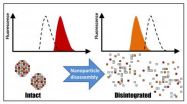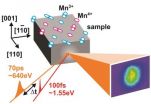(Press-News.org) HAMILTON, April 28, 2014 – Inspiration can come in many forms, but this one truly was a breath of fresh air.
A group of McMaster researchers has solved the problem of cumbersome, expensive and painfully slow water-testing by turning the process upside-down.
Instead of shipping water to the lab, they have created a way to take the lab to the water, putting potentially life-saving technology into the hands of everyday people.
The team has reduced the sophisticated chemistry required for testing water safety to a simple pill, by adapting technology found in a dissolving breath strip. Want to know if a well is contaminated? Drop a pill in a vial of water and shake vigorously. If the colour changes, there's the answer.
The development has the potential to dramatically boost access to quick and affordable testing around the world.
"We got the inspiration from the supermarket," says Carlos Filipe, a professor of chemical engineering who worked on the project.
The idea occurred to team member Sana Jahanshahi-Anbuhi, a PhD student in Chemical Engineering who came across the breath strips while shopping and realized the same material used in the dissolving strips could have broader applications.
The technology is expected to have significant public health applications for testing water in remote areas and developing countries that lack testing infrastructure, for example.
The researchers have now created a way to store precisely measured amounts of enzymes and other active agents in pills made from the same naturally occurring substance used in breath strips, putting lab-quality science within instant and easy reach of people who need quick answers to questions such as whether their water is safe.
"This is regular chemistry that we know works but is now in pill form," says John Brennan, director of McMaster's Biointerfaces Institute, where the work took place. "The user can be anybody in a village somewhere who can take a pill out of a bottle and drop it in water."
The material, called pullulan, forms a solid when dry, and protects sensitive agents from oxygen and temperature changes that can render them useless within hours. Until now, such agents have had to be stored at extremely cold temperatures and shipped in vials packed in huge chunks of dry ice, at great cost and inconvenience. Using them has been awkward, bulky and often wasteful.
The new method, described in an article published online in the prestigious European chemistry journal Angewandte Chemie, also holds promise for other applications, such as packaging that could change colour if food is spoiled.
"Can you modify packaging so it has a sensor to tell you if your chicken has gone off?" Brennan asks. "The reason that doesn't exist today is because there's no way you can keep these agents stable enough."
The new method allows the same materials to be stored virtually anywhere for months inside tiny pills that dissolve readily in liquid. The pills are inexpensive to produce and anyone can add them to well water, for an instant reading of pesticides,
e. coli or metals, for example.
The new technology can easily be scaled up and find its way to market quickly, says Brennan. Pullulan is already approved for wide commercial use and is mass produced, which can speed the journey to market.
INFORMATION:The McMaster team includes researchers from the departments of Chemical Engineering, Chemistry & Chemical Biology and Biochemistry and Biomedical Sciences. The project was funded by the Sentinel Bioactive Paper Network and the Natural Sciences and Engineering Research Council of Canada.
Editors and producers please note: Broadcast-quality video of the researchers describing the new technology is available here (with name identifiers): http://bit.ly/1itP4A6
and here (without name identifiers): http://bit.ly/QUDQ1v
A photo of John Brennan is here: http://bit.ly/QUEagN
A photo of Carlos Filipe is here: http://bit.ly/PKW3Ob
For more information or to arrange an interview, please contact:
Wade Hemsworth
Public Relations Manager
McMaster University
905-525-9140, ext. 27988
hemswor@mcmaster.ca
Michelle Donovan
Public Relations Manager
McMaster University
905-525-9140 ext. 22869
donovam@mcmaster.ca
A water test for the world
Scientists pack a lab into a pill, using an idea inspired by breath-freshening strips
2014-04-28
ELSE PRESS RELEASES FROM THIS DATE:
Technological advancements extend survival of transplanted hearts across species
2014-04-28
The use of transplant organs from animals (xenotransplantation) could help to compensate for the shortage of human organs available for transplant. NIH researchers have demonstrated that by using hearts from genetically engineered pigs in combination with target-specific immunosuppression of recipient baboons, organ survival can be significantly prolonged. This has potential for paving the way for the use of animal organs for transplantation into humans.
Toronto, ON, Canada, April 28, 2014 – Cardiac transplantation is the treatment of choice for end stage heart failure. ...
Disney Researchers use 3-D printing to produce interactive speakers of any shape
2014-04-28
Forget everything you know about what a loudspeaker should look like. Scientists at Disney Research, Pittsburgh have developed methods using a 3D printer to produce electrostatic loudspeakers that can take the shape of anything, from a rubber ducky to an abstract spiral.
The simple speakers require little assembly, but even those few manual steps might be eliminated in the future, said Yoshio Ishiguro, a Disney Research, Pittsburgh post-doctoral associate. "In five to 10 years, a 3D printer capable of using conductive materials could create the entire piece," he predicted.
The ...
Well-informed patients key to accepting gene-based drug dosing
2014-04-28
A new study out of Western University (London, Canada) illustrates the need for a lot more education around pharmacogenetics (PGx) –the study of how a patient's genes can affect drug reaction and dosage. PGx promises to optimize patient response to therapy, but this is the first study to really investigate how patients perceive this kind of genetic testing, and whether those perceptions differ when it comes to parents and their children. The research, led by Dr. Michael Rieder of Western's Schulich School of Medicine & Dentistry is published in the journal Pediatrics.
"Pharmacogenetic ...
The thin-crusted US Sierra Nevada Mountains: Where did the Earth go?
2014-04-28
Boulder, Colo., USA – In an addition to Geosphere's ongoing themed issue series, "Geodynamics and Consequences of Lithospheric Removal in the Sierra Nevada, California," Craig H. Jones of the University of Colorado Boulder and colleagues examine the seismological study of the entire extent of the U.S. Sierra Nevada range using seismograms collected in the Sierra Nevada EarthScope field experiment from 2005 to 2007.
The southern Sierra Nevada is known to have unusually thin crust for mountains with such high elevations (peaks higher than 4 km/14,000 ft, and average elevations ...
Precise brain mapping can improve response to deep brain stimulation in depression
2014-04-28
Experimental studies have shown that deep brain stimulation (DBS) within the subcallosal cingulate (SCC) white matter of the brain is an effective treatment for many patients with treatment-resistant depression. Response rates are between 41 percent and 64 percent across published studies to date.
One of the proposed mechanisms of action is the modulation of a network of brain regions connected to the SCC. Identifying the critical connections within this network for successful antidepressant response is an important next step.
A new study using MRI analysis of the ...
Wildfire outbreak in far eastern Russia
2014-04-28
According to the Voice of Russia, "As of Saturday morning, in Russia continue 103 wildfires at 27,412 hectares, including big 26 wildfires in the Far East and in Siberia. On Friday, 147 new fires began at 12,509 hectares, and 150 were extinguished at 5,437 hectares. Emergency situation has been introduced in the regions with most complicated situations - in the Amur region, in the Maritime and Baikal territories. This was according to the EMERCOM's (Emergency Control Ministry) spokesperson Alexander Drobyshevsky.
Satellites (such as Aqua and Terra) have located "1,587 ...
Cyberspace scholarship nets higher grades, better thinking for class Facebook group
2014-04-28
University students who used a Facebook group as part of a large sociology class did better on course assignments and felt a stronger sense of belonging, according to a Baylor University study.
The study has implications for the challenge of teaching large classes, a growing concern for higher education. Classes numbering hundreds of students — particularly in introductory courses — have become common at many universities, said researchers Kevin Dougherty, Ph.D., associate professor of sociology in Baylor's College of Arts and Sciences, and Brita Andercheck, a doctoral ...
Newborn Tropical Storm Tapah threatens Saipan and Tinian
2014-04-28
A tropical storm warning is in force for Saipan and Tinian as Tropical Storm Tapah moves north through the Northwestern Pacific Ocean on April 28. When NASA-NOAA's Suomi NPP satellite passed overhead and, imagery revealed a developing eye in Tapah.
In addition to the tropical storm warning, a typhoon watch is in effect for Alamagan and Pagan as Tapah is expected to continue in a generally northerly direction over the next couple of days. A typhoon watch means typhoon force winds of 74 mph or greater are possible within 48 hours. A tropical storm warning means tropical ...
Fluorescent-based tool reveals how medical nanoparticles biodegrade in real time
2014-04-28
Nanoparticles have been heralded as a potential "disruptive technology" in biomedicine, a versatile platform that could supplant conventional technologies, both as drug delivery vehicles and diagnostic tools.
First, however, researchers must demonstrate the properly timed disintegration of these extremely small structures, a process essential for their performance and their ability to be safely cleared out of a patient's body after their job is done. A new study presents a unique method to directly measure nanoparticle degradation in real time within biological environments.
"Nanoparticles ...
A glassy look for manganites
2014-04-28
Manganites – compounds of manganese oxides - show great promise as "go-to" materials for future electronic devices because of their ability to instantly switch from an electrical insulator to a conductor under a wide variety of external stimuli, including magnetic fields, photo-excitations and vibrational excitations. This ultrafast switching arises from the many different ways in which the electrons and electron-spins in a manganite may organize or re-organize in response to such external stimuli. Understanding the physics behind these responses is crucial for the future ...
LAST 30 PRESS RELEASES:
Australian team discover why quantum computers have memory problems over time
What determines the fate of a T cell?
Candida auris: genetic process revealed which could be treatment target for deadly fungal disease
Groundbreaking discovery turns household plastic recycling into anti-cancer medication
Blocking a key inflammatory pathway improves liver structure and vascular function in cirrhosis, study finds
Continuous spread: Raccoon roundworm detected in nine European countries
HKUST Engineering researchers developed a novel photodetector to enhance the performance of on-chip light monitoring
Strategic river sensors could have forewarned of Texas Camp flood disaster
Drone sampling of whale breath reveals first evidence of potentially deadly virus in Arctic
Roman soldiers defending Hadrian’s Wall infected by parasites, study finds
Pinochet’s prisoners were tormented with music but still found solace in it, a new book reveals
Fertility remains high in rural Tanzania despite access to family planning
AI-assisted device can improve autism care access
Kinetic careers
Uncovering how parasitic plants avoid attacking themselves to improve crop resistance
Nanoparticle vaccine strategy could protect against Ebola and other deadly filoviruses
Study finds brain care score can predict risk of stroke across racial groups
Key lung immune cells can intensify allergic reactions
Do hormones explain why women experience more gut pain?
New materials conduct ions in solids as easily as in liquids
Breakthrough of the Year: Renewable energy begins to eclipse fossil fuel-based sources
LLM use is reshaping scientific enterprise by increasing output, reducing quality and more
Introducing LightGen, a chip for ultra-fast, ultra-efficient generative AI
Astronomers see fireworks from violent collisions around nearby star
ACC/AHA issue new guideline on managing congenital heart disease in adults
Cosmic crash caught on camera
Is talented youth nurtured the wrong way? New study shows: top performers develop differently than assumed
Ants: An untapped resource in the development of antibiotics?
Archaeologists use AI to create prehistoric video game
Mitochondria migrate toward the cell membrane in response to high glucose levels
[Press-News.org] A water test for the worldScientists pack a lab into a pill, using an idea inspired by breath-freshening strips





